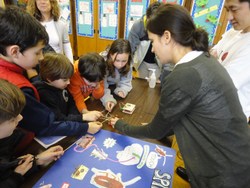
On Saturday, March 3, forty-five student volunteers hosted a Brain Fair at Nettelhorst Elementary School in Chicago’s Lake View neighborhood to celebrate Brain Awareness Week. This is the second year Shoai Hattori and Jessica Wilson, both PhD candidates in the Northwestern University Interdepartmental Neuroscience PhD Program (NUIN), organized the event.
Hattori and Wilson created the Brain Fair in an effort to educate and inspire the next generation of scientists.
“Especially now, when funding for science, technology, engineering, and mathematics (STEM) education is becoming increasingly scarce, students are less likely to learn about science in a fun, engaging manner that would make them want to pursue STEM careers,” says Hattori. “We thought it was important as scientists to excite and inspire youth about science to help increase the pipeline into STEM fields.”
The pair designed the day to engage children and families in neuroscience and to teach them about the motor and sensory systems.
“The Brain Fair is very important to us because it gives us the opportunity to educate the public not only about the brain, but about the progress and benefits of neuroscience research as well,” Hattori says. “For us researchers, it is very easy to get caught up in our little bubble of research, forgetting our obligation of making the public aware of what we do and where science is headed. The Brain Fair allows us to connect with the community and explain the importance and applications of our research.”
Hattori and Wilson planned and designed more than a dozen hands-on activities, each demonstrating a particular aspect of the brain, which volunteers from across the medical school facilitated during the event. The demonstrations included optical illusions, mirror drawing, prism goggles, and observing brains from different animals.
“The best part of the Brain Fair for me was watching the looks of surprise and joy on kids’ faces as they participated in the activities. For example, watching a cockroach’s leg ‘dance’ to James Brown songs, holding a sheep’s brain in their hands, and controlling lego mindstorm robots with electromyogram signals obtained from their own muscles. We worked hard to plan and implement activities that were fun and yet educational for all ages,” says Hattori.
About 500 people from across Chicago, double last year’s attendance, took part in the event, organizers said. David Schneeweis, PhD, assistant director of NUIN, provided faculty support to the student-led event.
“We live in an urban metropolis and it is a responsibility to give back to the community. We advertised this event for all families with children in the Chicago Public School system so we can reach different areas of the city,” he says. “The students that volunteer are interested in teaching, and the Brain Fair gives them experience in an informal setting to practice communicating with both adults and children about science.”
“People are excited by the Brain Fair. They want to learn, and parents ask questions just as much as their children do. It’s hugely affirming to get people excited in what you’re studying outside of an academic setting, and to be able to answer their questions,” says Wilson.






